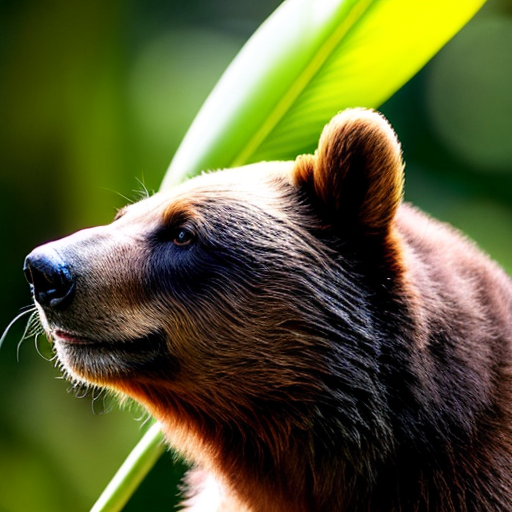Introduction to Bear Paw Plants: A Fascinating Succulent Species
Welcome, fellow plant enthusiasts, to the captivating world of bear paw plants! These peculiar succulents, also known as Cotyledon tomentosa, are sure to tickle your funny bone with their adorable resemblance to tiny bear paws. Now, let's dive into the important matter of caring for these delightful creatures. First off, bear paw plants thrive in bright, indirect light, so make sure to find them a cozy spot near a window. Remember, these little paws are not fans of soggy feet, so be cautious not to overwater them. Allow the soil to dry out between waterings, and you'll have a happy bear paw plant on your hands. Oh, and don't forget to give them a good laugh by occasionally tickling their fuzzy leaves with a soft brush. Trust me, it's a guaranteed way to keep these charming succulents entertained!
Creating the Ideal Environment: Providing Optimal Conditions for Bear Paw Plants
An interesting fact about caring for the bear paw plant (Cotyledon tomentosa) is that it has a unique adaptation to survive in its natural habitat. This succulent plant has evolved specialized leaves covered in dense, fuzzy hairs that resemble bear paws, hence its name. These hairs serve multiple purposes, including reducing water loss by trapping moisture around the plant, protecting it from intense sunlight, and deterring herbivores by providing a prickly texture. By understanding this adaptation, plant enthusiasts can mimic its natural environment by providing well-draining soil, limited direct sunlight, and infrequent watering to ensure the bear paw plant thrives in cultivation.
Welcome back, green thumbs, to the enchanting world of bear paw plants! Now that we've covered the basics of caring for these delightful succulents, let's talk about creating the ideal environment for them to thrive. Bear paw plants adore warm temperatures, so aim for a cozy range between 70-80°F (21-27°C). Additionally, these little paws appreciate a touch of humidity, so consider placing a tray of water near their habitat or misting them occasionally. As for their potting mix, a well-draining soil blend is key to prevent those precious paws from getting waterlogged. And last but not least, bear paw plants enjoy a light snack during the growing season, so feed them a diluted succulent fertilizer every few weeks. With these optimal conditions, your bear paw plants will be the envy of the succulent kingdom!
Nurturing Bear Paw Plants: Essential Care Tips and Techniques

Welcome, plant enthusiasts, to the wonderful world of bear paw plants! These charming succulents, with their fuzzy leaves resembling tiny bear paws, are a delightful addition to any plant collection. To ensure their health and happiness, here are some essential care tips and techniques to nurture your bear paw plants.
First and foremost, bear paw plants thrive in bright, indirect light. Find a cozy spot near a window where they can bask in the gentle rays of the sun. However, be cautious of exposing them to direct sunlight, as it can scorch their delicate leaves.
When it comes to watering, bear paw plants have a low tolerance for soggy soil. Allow the top inch of the soil to dry out between waterings, and then give them a thorough drink. Remember, it's better to underwater than overwater these little paws, as they are prone to root rot.
Proper drainage is crucial for the health of your bear paw plants. Ensure that their pots have drainage holes, and use a well-draining soil mix specifically formulated for succulents. This will prevent water from pooling around the roots and causing damage.
During the growing season, which typically occurs in spring and summer, bear paw plants appreciate a light feeding. Use a diluted succulent fertilizer every few weeks to provide them with the necessary nutrients. However, be cautious not to overfeed, as this can lead to excessive growth and a leggy appearance.
Lastly, don't forget to give your bear paw plants some love and attention. Occasionally, gently brush their fuzzy leaves with a soft brush to remove dust and stimulate growth. This will not only keep them looking their best but also provide a bit of entertainment for these delightful succulents.
By following these essential care tips and techniques, you'll be well on your way to nurturing healthy and happy bear paw plants. So, grab your gardening gloves and embark on this delightful journey of caring for these fascinating succulents. Happy gardening!
Troubleshooting Common Issues: Dealing with Problems in Bear Paw Plant Care
A fun fact about caring for bear paw plants is that they are actually quite low-maintenance! These unique succulents thrive in bright, indirect light and only need to be watered sparingly. In fact, overwatering can be detrimental to their health. So, if you tend to forget to water your plants, the bear paw plant might just be the perfect addition to your collection!
While caring for bear paw plants can be a joyous experience, it's not uncommon to encounter a few bumps along the way. Fear not, fellow plant enthusiasts, for I am here to help troubleshoot common issues in bear paw plant care. One common problem is overwatering, which can lead to root rot and a sad, droopy appearance. Remember to allow the soil to dry out between waterings and adjust your watering schedule accordingly. Another issue to watch out for is pests, such as mealybugs and spider mites, which can wreak havoc on your bear paw plants. Regularly inspect the leaves and stems, and if you spot any unwelcome visitors, treat them with an organic insecticidal soap or neem oil. Lastly, if your bear paw plant starts to lose its adorable fuzzy leaves, it may be a sign of insufficient light. Move it to a brighter location, but be cautious of direct sunlight, as it can scorch the leaves. With a little troubleshooting and tender care, your bear paw plants will overcome any obstacles and continue to bring joy to your plant collection.

